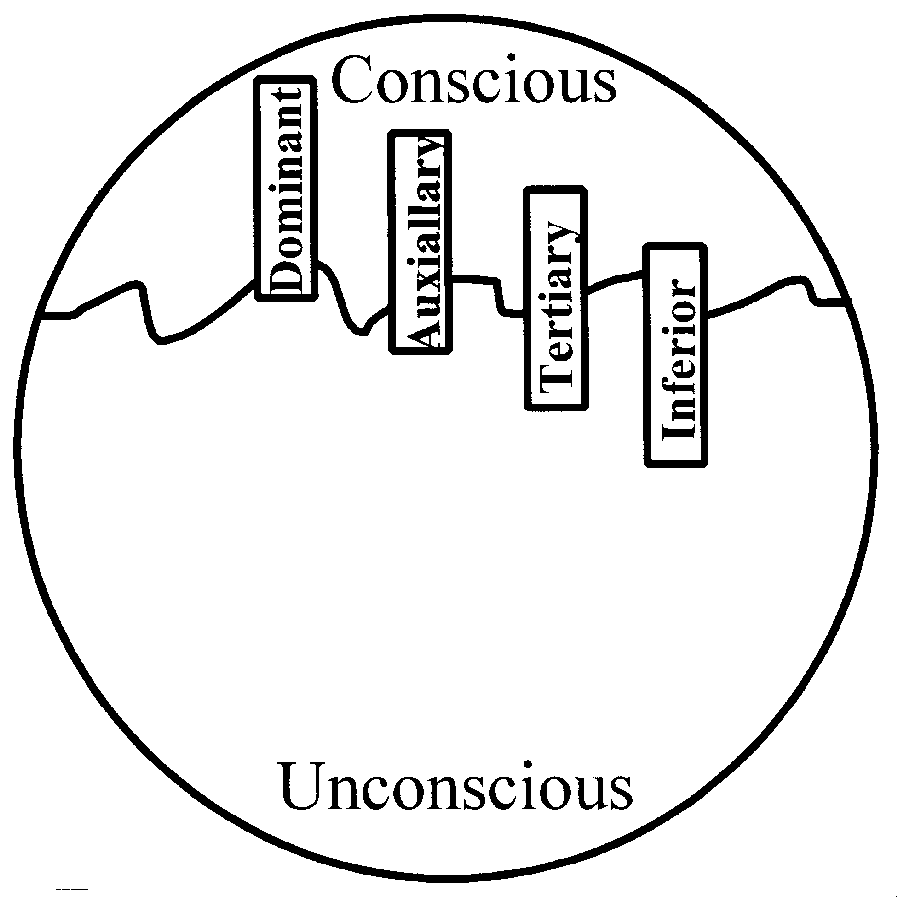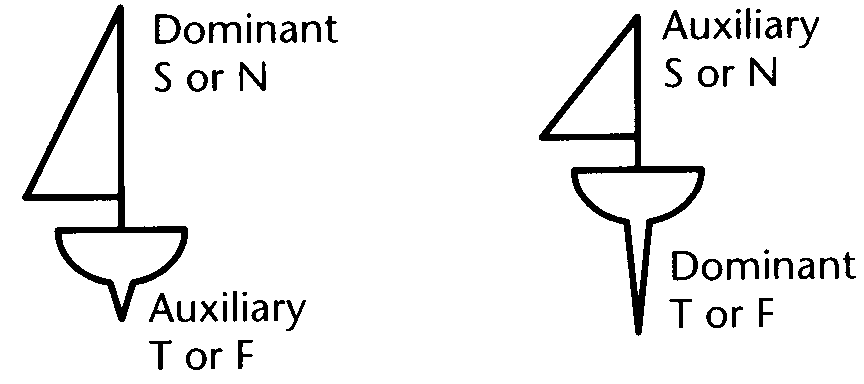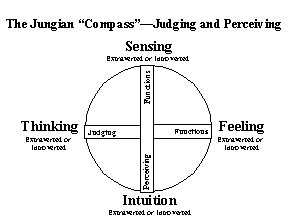Appreciating Differences - Jack Falt - Ottawa area,
Ontario, Canada
Return to Home Page
List of Articles by Jack Falt
Return to Type Table - Part 1
Appreciating Differences
Type Dynamics - Part 2
Once you have mastered the Type Table, the
next step is to use it to determine the Type Dynamics of each type.
Jung and Myers both found that a well balanced
type had two of the four mental functions that they were skilled at using.
One was used mainly in the outer world relating to objects and people;
and the other was used mainly in the inner world of thoughts and ideas.
Since an Introvert also has to live in the outer world, while the Extravert
has to go inside to think things over, it would seem that one of the two
functions identified in one's type need to be introverted while the other
needs to be extraverted.
Since we prefer to use these functions,
they get used more frequently and we become more skilled at using them.
Thus over time, we find that one of the mental functions becomes our strongest.
It would seem that our Type is an inborn pattern. We seem to have a 'natural'
skill of using our Dominant function. Since we use it well, this encourages
us to practise using it more. Thus, we become the most skilled at using
our Dominant function.
The strongest mental function is called
the Dominant. The second strongest is called the Auxiliary. These two functions
appear in the four letter designation of one's type.
Since Extraverts prefer to deal mainly
with the outer world, their strongest function, or Dominant, would also
be extraverted and the other mental function, the Auxiliary, would be introverted.
The opposite would be true for introverts. They prefer to deal mainly with
their inner world and this function, the Dominant, would be their strongest
and introverted. The other function. The Auxiliary, would be used to deal
with the outer world, and while the most evident to other people, it would
still be not quite as strong.
 Even
though we do not have all four functions in our type letters, we do use
them at various times. We tend to use these other two functions less frequently
and we are not as skilled in using them. The third in strength is called
the Tertiary function and the weakest one is called the Inferior function.
It is also found that our strongest function or Dominant is the one we
have the most conscious use of. The weaker our skill at using a function,
the more unconscious our use of it is. Thus under stress, when our use
of the Dominant hasn't worked, we often flip into using our Inferior function,
(i.e. being "in-the-grip") with sometimes disastrous consequences.
Even
though we do not have all four functions in our type letters, we do use
them at various times. We tend to use these other two functions less frequently
and we are not as skilled in using them. The third in strength is called
the Tertiary function and the weakest one is called the Inferior function.
It is also found that our strongest function or Dominant is the one we
have the most conscious use of. The weaker our skill at using a function,
the more unconscious our use of it is. Thus under stress, when our use
of the Dominant hasn't worked, we often flip into using our Inferior function,
(i.e. being "in-the-grip") with sometimes disastrous consequences.
So it is useful to know the hierarchy of
the functions of our type and to be able to identify it any of the other
16 types.
Sailboat: One way of getting a mental
picture of Extraverts having their Dominant function on the outside and
Introverts having their Dominant function on the inside, it to imagine
a sailboat. It has to have a sail to catch the wind and a keel to keep
it upright and moving in a straight line. Think of the sail as being the
extraverted function and the keel as being the introverted function.

For an extraverted boat, the sail is large
(Dominant) and the keel is small (Auxiliary). For an introverted boat,
the sail is small (Auxiliary) and the keel is large (Dominant).
With the extraverted boat, the large sail
catches every little breeze and moves the boat right along. But, because
of the small keel, there is not much below the surface to keep the boat
stable and in a straight line. Thus, the boat moves along quickly, changing
direction as the winds change.
With the introverted boat, the large keel
is more responsive to the below water currents and can stay in a straight
line longer. Since the sail is small, the boat does not move as fast. The
boat is controlled more by the underlying currents than the winds above.
Using the Type Table to Identify Type
Dynamics
In Extraverts the Dominant function is
also the function presented to the outer world. Look at the last letter
of the type to tell which function is presented to the outer world. A "J"
tells us that the Judging function (T or F) is the extraverted function
and is, therefore, the Dominant function. The other middle letter (S or
N) is the Auxiliary and, to give balance to the type, is introverted. A
"P" tells us that the Perceiving function (S or N) is the extraverted function
and is, therefore, the Dominant function. The other middle letter (T or
F) is the Auxiliary and, to give balance, is introverted.
For Introverts the Auxiliary function is
the one presented to the world. Their strongest function is hidden. For
introverted types, a "J" at the end of the type tells us that the function
presented to the world is a Judging function (T or F) but it is only the
Auxiliary. The other middle letter (S or N) is their Dominant. A "P" at
the end of an introverted type tells us that the Perceiving function (S
or N) is the extraverted function and is, therefore, the Auxiliary function.
The other middle letter (T or F) is the Dominant and, to give balance,
is introverted.
The Judging Top and Bottom Rows
Begin by looking at the top and bottom
rows of the Type Table. All eight of these types have a J at the end of
the type. This tells us that the extraverted function is the Judging function
(T or F).
Using the Bottom Row
EJ Types - Look at a Type Table. Find
the bottom "J" row. Now go along each of the four types in bottom row and
circle the Judging function (a Tor F). This is the extraverted function.
For those four functions that start with an E, this is also the Dominant
function. Put a small subscript e beside the function letter
to indicate that it is extraverted: Te or Fe.
Now underline the other middle letter.
This is the Auxiliary and put a small subscript i beside it
to indicate that it is introverted: Si or Ni.
Using the Top row
IJ Types - Now for those four types
in the top row that start with an I, underline the Judging function (T
or F) as this is the Auxiliary function. Put a small subscript e,
to indicate that it is extraverted, beside the function letter: Te
or Fe.
Then circle the other middle letter or
the Perceiving function as this is the Dominant for Introverts. Put a small
subscript i beside it to indicate that this function is introverted:
Si or Ni.
Thus for the top and bottom rows the same
inner letters are introverted or extraverted. The differences is that the
extraverted functions on the bottom row are also the Dominant function,
while the introverted functions on the top row are the Dominant function.
The Perceiving Middle Two Rows
Now look at the middle two rows of the
Type Table. All of these eight types have a P at the end of the type. This
tells us that the extraverted function is the Perceiving function (S or
N).
The Lower Middle row
EP Types - The bottom middle row has the extraverted
types. The P at the end of the type tells us that the S or N are the extraverted
functions and because the types are extraverted, the S or N is also the
Dominant function. So go along the lower middle row and circle either the
S or N. To show that it is also an extraverted function place a subscript
e
beside it: Se or Ne.
Next, on this same lower middle row, underline
the other letter (T or F) as this is the Auxiliary function. Place a small
subscript i beside the letter to indicate that it is also an
introverted function: Ti or Fi.
The Upper Middle Row
I P Type - The upper middle row has the introverted
types. The P at the end of the type tells us that the S or N are the extraverted
functions and because the types are introverted, the S or N is the Auxiliary
function. So go along the upper middle row and underline either the S or
N. To show that it is also an extraverted function place a subscript e
beside it: Se or Ne.
Next, on this same lower middle row, circle
the other letter (T or F) as this is the Dominant function. Place a small
subscript i beside the letter to indicate that it is also an
introverted function: Ti or Fi.
As an example, you should have ENeTiP
and ISiFeJ. (The larger
letter represents the circled Dominant.)
Isabel Myers (Gifts Differing, 1980)
made up this little rhyme to help you remember which is the Dominant function:
An extravert who has forgotten
his
can ask a JP which one it is.
But when an introvert's forgot,
JP tells him which one it's not!
The Tertiary and Inferior Functions
Now that we know now to identify the Dominant
and Auxiliary for any type using the type Table, let's look at how to identify
the Tertiary and the Inferior functions. If we look on Jung's Compass of
the Functions we see that the S is opposite the N, and T is opposite the
F. These are considered the polar opposites. But when we are talking about
opposites we are also identifying opposite attitudes. Thus, the polar opposite
of Si is Ne. The polar opposite of Te
is Fi.

For a type to have good balance there
should be an equal number of extraverted and introverted functions. Thus
if the Dominant is extraverted, and the Auxiliary is introverted, then
the Tertiary is extraverted and the Inferior is introverted. They alternate
extraversion-introversion. If the Dominant is introverted and the Auxiliary
is extraverted, then the Tertiary is Extraverted and the Inferior is introverted.
The Dominant and the Tertiary have the same attitude (extraverted or introverted),
and so do the Auxiliary and the Inferior. (Jung and Myers lumped the Auxiliary,
Tertiary and Inferior functions as all having the same attitude. Research
and practical experience would seem to favour the alternating attitudes.)
For ENFJ Type, the Dominant is Fe,
the Auxiliary is Ni, the Tertiary will be the polar opposite
of Auxiliary or Se, and the Inferior will be the polar opposite
of the Dominant or Ti.
For the ISTP Type, the Dominant is Ti,
the Auxiliary is Se, the Tertiary will be the polar opposite
of the Auxiliary or Ni. And the Inferior will be the polar opposite
of the Dominant or Te.
Fill in the rest of the Tertiary and Inferior
functions on your Type Table. Compare your answers with the table
below.
Type Dynamics of
the 16 Types
ISTJ
Dom. - Si
Aux. - Te
Tert. - Fi
Infer. - Ne |
ISFJ
Dom. - Si
Aux. - Fe
Tert. - Ti
Infer. - Ne |
INFJ
Dom. - Ni
Aux. - Fe
Tert. - Ti
Infer. - Se |
INTJ
Dom. - Ni
Aux. - Te
Tert. - Fi
Infer. - Se |
ISTP
Dom. - Ti
Aux. - Se
Tert. - Ni
Infer. - Fe |
ISFP
Dom. - Fi
Aux. - Se
Tert. - Ni
Infer. - Te |
INFP
Dom. - Fi
Aux. - Ne
Tert. - Si
Infer. - Te |
INTP
Dom. - Ti
Aux. - Ne
Tert. - Si
Infer. - Fe |
ESTP
Dom. - Se
Aux. - Ti
Tert. - Fe
Infer. - Ni |
ESFP
Dom. - Se
Aux. - Fi
Tert. - Te
Infer. - Ni |
ENFP
Dom. - Ne
Aux. - Fi
Tert. - Te
Infer. - Si |
ENTP
Dom. - Ne
Aux. - Ti
Tert. - Fe
Infer. - Si |
ESTJ
Dom. - Te
Aux. - Si
Tert. - Ne
Infer. - Fi |
ESFJ
Dom. - Fe
Aux. - Si
Tert. - Ne
Infer. - Ti |
ENFJ
Dom. - Fe
Aux. - Ni
Tert. - Se
Infer. - Ti |
ENTJ
Dom. - Te
Aux. - Ni
Tert. - Se
Infer. - Fi |
Return to Type Table - Part 1
Return to Home Page
List of Articles by Jack Falt
 Even
though we do not have all four functions in our type letters, we do use
them at various times. We tend to use these other two functions less frequently
and we are not as skilled in using them. The third in strength is called
the Tertiary function and the weakest one is called the Inferior function.
It is also found that our strongest function or Dominant is the one we
have the most conscious use of. The weaker our skill at using a function,
the more unconscious our use of it is. Thus under stress, when our use
of the Dominant hasn't worked, we often flip into using our Inferior function,
(i.e. being "in-the-grip") with sometimes disastrous consequences.
Even
though we do not have all four functions in our type letters, we do use
them at various times. We tend to use these other two functions less frequently
and we are not as skilled in using them. The third in strength is called
the Tertiary function and the weakest one is called the Inferior function.
It is also found that our strongest function or Dominant is the one we
have the most conscious use of. The weaker our skill at using a function,
the more unconscious our use of it is. Thus under stress, when our use
of the Dominant hasn't worked, we often flip into using our Inferior function,
(i.e. being "in-the-grip") with sometimes disastrous consequences.

